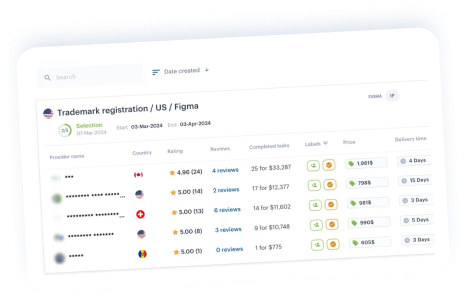In this edition of iPNEWS, we explore the growing role of artificial intelligence in IP examination. The United States Patent and Trademark Office (USPTO) has officially launched DesignVision, an internal AI tool designed to assist examiners in searching and analyzing design patents.
Introduction
To understand how this shift toward AI-assisted examination might influence filing strategies and timelines, we reached out to experts on the iPNOTE platform who work closely with patent offices and corporate clients worldwide.
Among them is Dhiraj Jindal, Patent Agent and Head of Operations at Patent Yogi LLC, who shared his insights on what the launch of DesignVision means for applicants and practitioners.
The USPTO has launched DesignVision, an AI-based internal tool aimed at improving search efficiency and reducing examination timelines for design patents.
According to Dhiraj Jindal, Patent Agent and Head of Operations at Patent Yogi LLC:
DesignVision is not currently publicly available — it’s an internal USPTO tool for design patent examiners, integrated into the PE2E (Patents End-to-End) search suite. So, we do not have firsthand knowledge of the tool.
We are sharing information below based on our research.
How DesignVision changes U.S. design search & examination?
- Image-first, multi-register search. Examiners can upload up to seven images and run a federated, similarity-ranked search across 80+ U.S. and foreign design/industrial design registers (incl. WIPO/EUIPO) inside the PE2E suite. This centralizes what used to be fragmented, manual workflows.
- Richer controls = tighter art discovery. Examiners can weight visual features, focus on specific portions of an image, and layer Locarno/text filters—all of which should surface closer “look-alike” prior art faster.
- Transparency in the record. Use of DesignVision is logged in the file wrapper (search notes/history), so applicants will see that the tool was used during examination.
- Policy intent: reduce pendency & modernize. USPTO positions this as part of a broader push to streamline examination and reduce design pendency.
Advantages & limitations for businesses (and “can it be trusted?”)
Advantages:
- Earlier risk detection. Because examiners can surface closer look-alikes, expect tighter novelty/overall visual impression checks; if you mirror that capability pre-filing you can reduce surprise refusals.
- Clearer prosecution narrative. Since DesignVision usage appears in the record, you can tailor responses knowing how the examiner searched.
- Potentially faster outcomes. USPTO explicitly links the tool to lower pendency; several legal analyses also anticipate quicker, more consistent decisions due to better art retrieval.
Limitations:
- Not publicly accessible. Only USPTO design examiners have access today; applicants cannot run DesignVision directly. You’ll need surrogate tools (see below).
- AI ≠ legal judgment. It’s an examiner aid, not a decision engine; findings must still be weighed under U.S. design law. (Comparable offices stress that AI outputs aren’t “official opinions.”)
- Coverage ≠ completeness. Even with 80+ registers, no AI image index is perfectly comprehensive or recall-optimal; near-miss stylings, obscured views, or unusual claim scopes can still be missed. (USPTO notices and commentary frame the tool as assistance, not determinism.)
Bottom line on trust: Treat DesignVision as a powerful examiner aid that will likely raise the bar on cited visual prior art. It’s credible for what it is, but it doesn’t replace legal analysis or eliminate the need for your own searching.
Where it can give you a competitive advantage?
(Even without direct access, you can “think like the examiner” and approximate the workflow.)
- Pre-filing “look-alike” clearance. Use public AI image-search tools for designs—e.g., EUIPO’s DesignView/TMview image search and WIPO Global Brand Database image similarity—to stress-test your renders from multiple views before filing.
- Claiming strategy. If image-based searching surfaces close shapes/contours, adjust line thickness, broken lines, views, and disclaimers to focus the claimed visual features and preserve distance over cited art. (This aligns with the reality that examiners will see more similar art.)
- Faster prosecution planning. Expect “better art, earlier.” Prepare evidence packets (comparison tables, annotated views) anticipating that a similarity-ranked set will be in the record.
- Portfolio monitoring. Run periodic image-similarity sweeps in EUIPO/WIPO tools to spot look-alikes globally, informing enforcement and design refresh cycles.
Have other countries done similar things?
- EUIPO (Europe): Has AI-assisted image searching in TMview and (by extension) tooling around designs/DesignView; practitioners report speed/accuracy improvements in search tasks, though EUIPO design examination itself remains largely formalities-based and rapid (often immediate registration on formalities compliance).
- CNIPA (China): Public materials describe intelligent search/examination (including for designs) to improve efficiency and quality; policy overviews state AI is helping shorten and streamline examination, but again without office-verified, design-specific pendency deltas.
- Japan (JPO): Broader AI adoption (classification, trademark image tools) coincides with reduced overall patent pendency (e.g., FA ~9–10 months, total ~13–14 months), evidencing that AI-supported workflows can correlate with speed gains, though this is not design-specific causation.
Practical next steps for you (as an applicant/attorney/agent)
- Mirror the examiner: Run image-similarity sweeps in EUIPO DesignView/TMview and WIPO tools before U.S. filing to gauge what DesignVision might surface.
- File with prosecution in mind: Provide clean, consistent multi-view images; consider strategic use of broken lines and disclaimers to isolate the novel visual impression. (DesignVision’s feature-weighting will “home in” on what you show.)
- During prosecution: If the file history shows DesignVision use, craft visual side-by-sides addressing the specific features likely weighted in the search (contours, silhouette, proportion).
Conclusion
The introduction of DesignVision marks a significant step in the USPTO’s digital transformation. By embedding AI into the design examination process, the Office aims to improve search consistency and reduce pendency while maintaining examiner oversight.
As Dhiraj Jindal notes, tools like DesignVision will likely raise the quality bar for prior-art discovery — challenging applicants to refine their pre-filing searches and claim strategies.
We thank Dhiraj Jindal for sharing his professional perspective with iPNEWS readers and contributing to the ongoing dialogue on how AI continues to reshape intellectual property practice.






